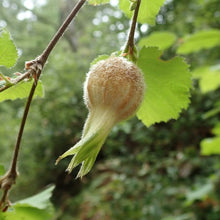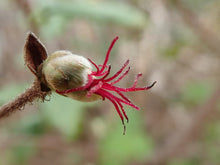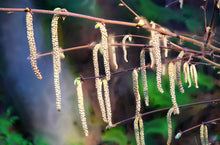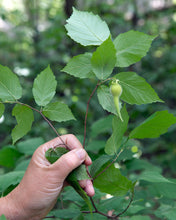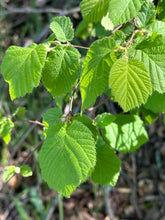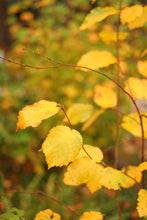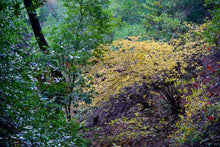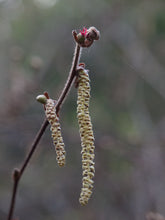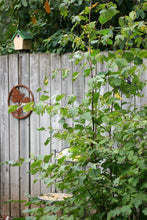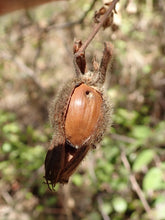
Corylus cornuta ssp californica
Western, or beaked, hazelnut is a deciduous, multi-stemmed small tree (or large shrub) with vase-like arching branches. It has saw-toothed leaves that are notably soft in both texture and color; velvet to the touch and sweet on the eyes. It is one of the first blooming plants, with blooms that are showy insofar as the competition is slim in January, and certainly a welcomed reminder of spring to come. In fall, the leaves turn golden-yellow and, if pollination has occurred, fruits mature into hard-shelled edible nuts, which are collected by birds, small mammals and only the most astute gardeners that can outwit the wildlife.
This species is monoecious - which means both male and female parts are contained in one plant. The effect is that you're rewarded by the visual interest of both types of flowers; puffy clusters of red female stigmas, tiny and rather unnoticeable to the naked eye, but strikingly ornate under a magnifying glass and pale-yellow male catkins that dangle from the branch tips. Although some monoecious plants can self-pollinate, many species have mechanisms to prevent self-pollination and encourage cross-pollination for greater genetic diversity. There is uncertainty in the literature as to whether (and how much) this species/variety may be self-fertile. In any case, if possible, self-fertility would be rare and inferior in terms of promoting genetic resilience. Therefore, it is generally recommended to plant more than one in relative proximity (ideally less than 100ft apart) to create nuts.
- Plant type/canopy layer: deciduous, perennial, large shrub or small tree
- Size at maturity: 2'-14' high; 10'-20' wide
- Light requirements: full sun, part sun/part shade, full shade
- Moisture requirements: moist to dry soils
- Bloom time: Jan - March
- Growth rate/ease: fast growing, easy to grow
- Wildlife support: flowers attract and provide nectar to adult butterflies; fruits (in this case nuts) are collected by many species of mammals and birds, especially native jays squirrels and chipmunks; the foliage is eaten by rabbits and deer; the overall plant attracts and supports beneficial and other pest eating insects, is a caterpillar host plant and larval food source for native butterflies and moths
- Native habitat/range: grows on moist, rocky slopes, streambanks and riparian areas, in the understory or at the edge of mixed forests, and lakeshores, from sea level to 1800m, generally from the Cascades to the coast across the Pacific Northwest. Portland Plant List - yes.
- Special features & uses: wildlife favorite; edible nuts; ethnobotanically this plant has been exceptionally important to indigenous folks for millennia and strategic fire regimes were historically used to maintain optimal conditions and to maximize nut production, which were collected for eating and trade, twiggy new growth can be used to build common household products like fish traps, baskets, and baby carriers; landscape uses include; erosion control, habitat hedgerows, windbreaks
Gardening with Western Hazelnut: This plant is not fussy. Ideally, it prefers part sun/part shade locations with moist, well-drained soils but it can tolerate full sun to full shade and summer drought in shady spots. It's a perfect choice for pollinator and woodland gardens.
Photo Credit 1, 2, 10: © joergmlpts, some rights reserved (CC-BY)
Photo Credit 3: "File:California hazelnut (Corylus cornuta californica) (4361407132).jpg" by Franco Folini from San Francisco, USA is licensed under CC BY-SA 2.0.
Photo Credits 4 & 9: © Michael Warner, some rights reserved (CC-BY)
Photo Credit 5: © Irina Mitine, some rights reserved (CC-BY)
Photo Credit 6: "Corylus cornuta (Beaked Hazel)" by Plant Image Library is licensed under CC BY-SA 2.0
Photo Credits 7 & 8: Karli Del Biondo, Beetles and Bees










